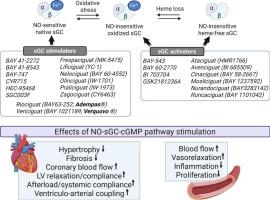探索可溶性胍基环化酶刺激剂和激活剂在心力衰竭中的潜力。
IF 5.6
2区 医学
Q1 PHARMACOLOGY & PHARMACY
引用次数: 0
摘要
心力衰竭(HF)是一种危及生命的疾病,其特点是发病率和死亡率都很高。然而,尽管最近取得了进展,预后仍然很差。环鸟苷3',5'-单磷酸(cGMP)介导多种细胞类型的广泛生理过程。它的缺乏与许多病理性心血管疾病有关,包括心衰、肺动脉高压(PH)和肾脏疾病。因此,恢复和增强一氧化氮(NO)-可溶性鸟酰环化酶(sGC)-cGMP信号通路似乎具有深远的治疗潜力。sGC刺激剂和激活剂的发现标志着NO-sGC-cGMP药理学领域的一个里程碑,使no不依赖于cGMP信号传导而不形成no衍生自由基的长效增强成为可能。十多年前,sGC刺激剂riociguat被批准用于治疗肺动脉高压(PAH)和慢性血栓栓塞性PH (CTEPH)。最近,sGC刺激剂vericiguat被批准用于治疗症状性慢性心衰。目前正在研究一些用于治疗慢性肾脏疾病的sGC激活剂。本文综述了NO-sGC-cGMP信号在心血管和心功能调节中的证据,重点介绍了sGC刺激剂和sGC激活剂在HF亚型中的临床前和临床证据。在HF伴射血分数降低(HFrEF)的临床试验中已经观察到有希望的结果,但在HF伴射血分数保留(HFpEF)的临床试验中则没有。需要进一步的研究来确定sGC激动剂在心衰和相关心肾疾病中的确切作用机制,以充分利用其治疗潜力,并解决在常规临床实践中实施这些药物的挑战。本文章由计算机程序翻译,如有差异,请以英文原文为准。

Exploring the potential of soluble guanylyl cyclase stimulators and activators in heart failure
Heart failure (HF) is a life-threatening disease characterized by substantial morbidity and mortality. Yet despite recent advances, prognosis remains poor. Cyclic guanosine 3′,5′-monophosphate (cGMP) mediates a wide range of physiological processes in various cell types. Its deficiency has been implicated in numerous pathological cardiovascular diseases, including HF, pulmonary hypertension (PH), and kidney disease. Therefore, restoring and enhancing the nitric oxide (NO)–soluble guanylyl cyclase (sGC)–cGMP signalling pathway appears to have far-reaching therapeutic potential.
The discovery of sGC stimulators and activators marked a milestone in the field of NO–sGC–cGMP pharmacology, enabling NO-independent and long-acting enhancement of cGMP signalling without the formation of NO-derived radicals. Over a decade ago, the sGC stimulator riociguat was approved for the treatment of pulmonary arterial hypertension (PAH) and chronic thromboembolic PH (CTEPH). More recently, the sGC stimulator vericiguat was approved for symptomatic chronic HF. A number of sGC activators are currently being investigated for the treatment of chronic kidney diseases.
This review summarizes the evidence for NO–sGC–cGMP signalling in the regulation of cardiovascular and cardiac function, focusing on preclinical and clinical evidence for sGC stimulators and sGC activators in HF subtypes. Promising results have been observed in clinical trials of HF with reduced ejection fraction (HFrEF), but not in clinical trials of HF with preserved ejection fraction (HFpEF). Further studies are needed to determine the precise mechanisms of action of sGC agonists in HF and associated cardiorenal diseases to fully leverage their therapeutic potential and address the challenges of implementing these agents in routine clinical practice.
求助全文
通过发布文献求助,成功后即可免费获取论文全文。
去求助
来源期刊

Biochemical pharmacology
医学-药学
CiteScore
10.30
自引率
1.70%
发文量
420
审稿时长
17 days
期刊介绍:
Biochemical Pharmacology publishes original research findings, Commentaries and review articles related to the elucidation of cellular and tissue function(s) at the biochemical and molecular levels, the modification of cellular phenotype(s) by genetic, transcriptional/translational or drug/compound-induced modifications, as well as the pharmacodynamics and pharmacokinetics of xenobiotics and drugs, the latter including both small molecules and biologics.
The journal''s target audience includes scientists engaged in the identification and study of the mechanisms of action of xenobiotics, biologics and drugs and in the drug discovery and development process.
All areas of cellular biology and cellular, tissue/organ and whole animal pharmacology fall within the scope of the journal. Drug classes covered include anti-infectives, anti-inflammatory agents, chemotherapeutics, cardiovascular, endocrinological, immunological, metabolic, neurological and psychiatric drugs, as well as research on drug metabolism and kinetics. While medicinal chemistry is a topic of complimentary interest, manuscripts in this area must contain sufficient biological data to characterize pharmacologically the compounds reported. Submissions describing work focused predominately on chemical synthesis and molecular modeling will not be considered for review.
While particular emphasis is placed on reporting the results of molecular and biochemical studies, research involving the use of tissue and animal models of human pathophysiology and toxicology is of interest to the extent that it helps define drug mechanisms of action, safety and efficacy.
 求助内容:
求助内容: 应助结果提醒方式:
应助结果提醒方式:


